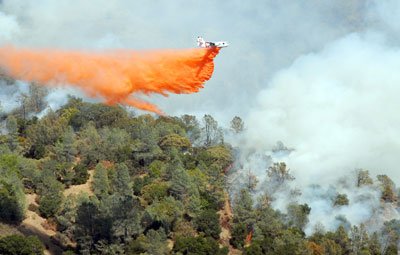Laying in my backyard hammock late Sunday afternoon, I heard the
sound of sirens screaming down nearby East Dunne Avenue. After
counting more than a dozen emergency vehicles blare by, I figured
it was time to check out what all the commotion was about.
Laying in my backyard hammock late Sunday afternoon, I heard the sound of sirens screaming down nearby East Dunne Avenue. After counting more than a dozen emergency vehicles blare by, I figured it was time to check out what all the commotion was about.
Like many South Valley residents, I watched the anvil-shaped cloud bloom over the Diablo mountain range. “That’s one hell of an inferno,” I told a neighbor as we gazed at the smoke roiling over the distant ridge.
The Lick fire that’s now burning many thousands of acres in Henry Coe State Park gives us all a vivid reminder that South Valley’s backcountry can be dangerous territory. Despite all their apparent destruction, however, wildfires play an important part in preserving California’s natural environment. They serve as Mother Nature’s way of doing her housecleaning and gardening chores.
Fires help clear old brush and grass growth, allowing fresh young plants to grow. They help control bugs and diseases that could devastate a vegetation species. Their ash adds nutrients to the soil. And various plants species have evolved to use fire’s heat to germinate their seeds.
Like it or not, wildfires are a necessity in California’s natural ecology. That’s a fact the ancient Native Americans understood better than we modern people today. By living so closely with the land, the California’s indigenous cultures learned how wildfires helped sustain the diversity of habitats in chaparral, grassland and forests. The Native Americans even purposefully set fires on occasions when they deemed it necessary to benefit the land.
But in the 20th century, as California grew into the most populous American state, many homes and communities were built in chaparral and grassland environments – including here in the South Valley region. Ignorant of the importance of fire’s role in maintaining the health of the environment, government leaders initiated aggressive fire suppression policies to try to eliminate fire from the environment. Unfortunately, this had undesirable consequences.
Our best human intentions to control the natural world can at some point in time actually hurt us. Over the decades of this government-promoted fire suppression policy, the vegetation fuel built up throughout the state. And when that fuel does eventually light – as is bound to happen during a lightning strike, or from human carelessness or arson – the energy contained in it burns with much greater destructive force than Mother Nature ever intended over millions of years of environmental evolution.
The South Valley found this out the hard way in the Croy fire that ate away at the rural terrain west of Morgan Hill in September 2002. That conflagration burned more than 3,000 acres and took seven days to contain. Thirty-four homes were lost. We also saw the impact of a wildfire in an urban setting in October 1991 when the East Bay Hills section of Oakland went up in smoke. In that inferno, high winds whipped up flaming dry grass and eucalyptus trees surrounding multi-million-dollar houses. More than 3,300 homes were destroyed in the worst disaster in the United States that year.
About 8.5 percent of California is covered by chaparral habitat. Much of the states also includes rural areas of grassy wildlands and forests. Hundreds of thousands of acres of this rugged terrain has not had a good cleaning-out fire for too many decades. During that time, the fuel has increased as layer upon layer of annual vegetation growth builds up the fuel source. Luckily, we’re starting to better manage this danger through controlled burns – something that has helped firefighters in combating the Lick fire.
As our state’s population explodes to more than 50 million people in the next 20 years, many more homeowners will find themselves living in or on the border of natural settings which are highly susceptible to fires in the dry months of the year. No doubt, many of these people will face the terror of hillsides surrounding their homes erupting in a fast-moving wildfire. And as global warming increases the likelihood of periods of long drought hitting our state, there will be an increasing climb in fire danger.
As for the recent Lick Fire this week, fortunately it has so far burned an area where no homes stand. Next time, however, South Valley might not be so lucky. We need to remember we dwell on the edge of danger. A Sunday afternoon nap in a backyard hammock could be quickly cut short with a raging wildfire drawing near.













